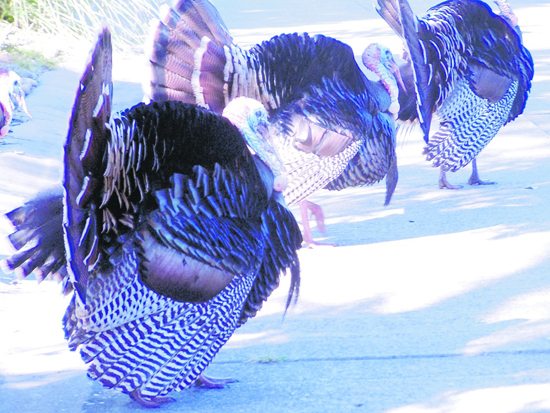| | Published November 7th, 2012
| ASK CYNTHIA: Reader Requests
| |  | |
|
Hi Cynthia:
 At least three times a week when I return from work, turkeys are trotting through our neighborhood. They don't seem to bother my yard, but some neighbors aren't so happy with them. Should I do anything to protect my plants?
At least three times a week when I return from work, turkeys are trotting through our neighborhood. They don't seem to bother my yard, but some neighbors aren't so happy with them. Should I do anything to protect my plants?
 Janet
Janet
 Orinda
Orinda

 Hi Janet:
Hi Janet:
 This is a trick question because you'll get a different answer depending on whom you ask. Turkeys are omnivores. They forage through the day for plants, berries, leaves, insects, reptiles, and small amphibians tending to feed most heavily a few hours after leaving their roosts in the morning and before sunset. (Their evening meal is probably what you witness when you return from work.) If you were a wheat or corn farmer, you'd probably be roasting wild turkey for Thanksgiving as well as Sunday dinners since in agriculture these gobblers can be a nuisance.
This is a trick question because you'll get a different answer depending on whom you ask. Turkeys are omnivores. They forage through the day for plants, berries, leaves, insects, reptiles, and small amphibians tending to feed most heavily a few hours after leaving their roosts in the morning and before sunset. (Their evening meal is probably what you witness when you return from work.) If you were a wheat or corn farmer, you'd probably be roasting wild turkey for Thanksgiving as well as Sunday dinners since in agriculture these gobblers can be a nuisance.

 However, we live in rural Lamorinda and in my opinion, one of the main benefits is our proximity to nature and open space with the sounds and sights of both domestic and wild animals and birds. When I see the setting sun in my rearview mirror as I cross the Bay Bridge, I breathe a sigh of relief knowing that fresh air and natural beauty await me just a few miles away.
However, we live in rural Lamorinda and in my opinion, one of the main benefits is our proximity to nature and open space with the sounds and sights of both domestic and wild animals and birds. When I see the setting sun in my rearview mirror as I cross the Bay Bridge, I breathe a sigh of relief knowing that fresh air and natural beauty await me just a few miles away.

 Yes, I am in the camp of enjoying the turkeys. For the past few years I've had several flocks living and dining chez moi. My front lawn is almost bug and weed free thanks to them devouring insects, grubs, seeds, and wild grasses. They keep down the hundreds of unwanted oaks, plums, and pines as they eat acorns, fallen fruit, and nuts on the hillside. Watching the toms puff, primp, and putt as they court the hens is entertaining and when the poults hatch, they gorge on my snails, slugs, grasshoppers, beetles, and other nasty insects that actually do damage my plants. I collect turkey feathers to use in floral arrangements and their fertilizer nourishes my soil and my compost pile.
Yes, I am in the camp of enjoying the turkeys. For the past few years I've had several flocks living and dining chez moi. My front lawn is almost bug and weed free thanks to them devouring insects, grubs, seeds, and wild grasses. They keep down the hundreds of unwanted oaks, plums, and pines as they eat acorns, fallen fruit, and nuts on the hillside. Watching the toms puff, primp, and putt as they court the hens is entertaining and when the poults hatch, they gorge on my snails, slugs, grasshoppers, beetles, and other nasty insects that actually do damage my plants. I collect turkey feathers to use in floral arrangements and their fertilizer nourishes my soil and my compost pile.

 My advice is to smile, get out your camera, and photograph these striking native birds knowing that they are protecting and enriching your garden and your pastoral experience. If you notice them munching your prized plants, hoot and holler and they'll run rapidly away...another terrific photo opportunity!
My advice is to smile, get out your camera, and photograph these striking native birds knowing that they are protecting and enriching your garden and your pastoral experience. If you notice them munching your prized plants, hoot and holler and they'll run rapidly away...another terrific photo opportunity!
 Wishing you double gobbles!
Wishing you double gobbles!
 Happy Gardening!
Happy Gardening!
 Cynthia
Cynthia
 Cynthia Brian
Cynthia Brian
 The Goddess Gardener
The Goddess Gardener
 Cynthia@GoddessGardener.com
Cynthia@GoddessGardener.com
 www.GoddessGardener.com
www.GoddessGardener.com
 925-377-7827
925-377-7827
 I am available as a speaker, designer, and consultant.
I am available as a speaker, designer, and consultant.

 (c)2012 Cynthia will answer one or two questions per issue as space allows. Email your comments or questions to Cynthia@GoddessGardener.com .
(c)2012 Cynthia will answer one or two questions per issue as space allows. Email your comments or questions to Cynthia@GoddessGardener.com .

|
| | | | | | | | | | | | Advertisement | | |
| | | print story
Before you print this article, please remember that it will remain in our archive for you to visit anytime.
download pdf
(use the pdf document for best printing results!) | | | Comments | | |
| | | | | | | | | | | | | | | | |


